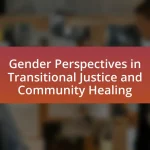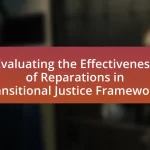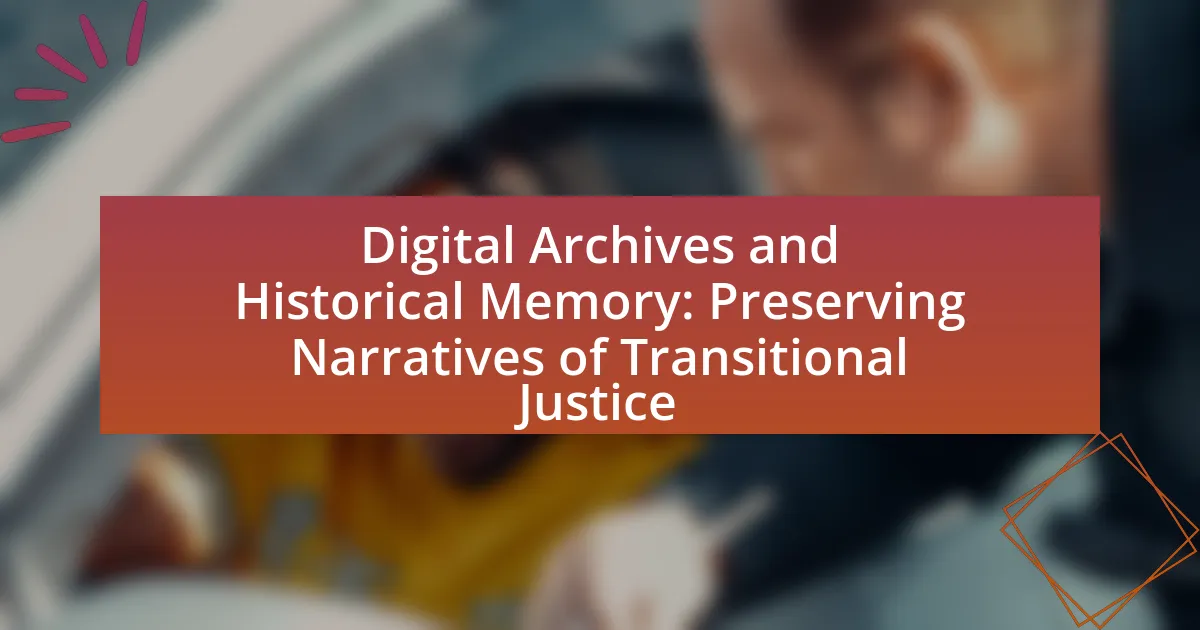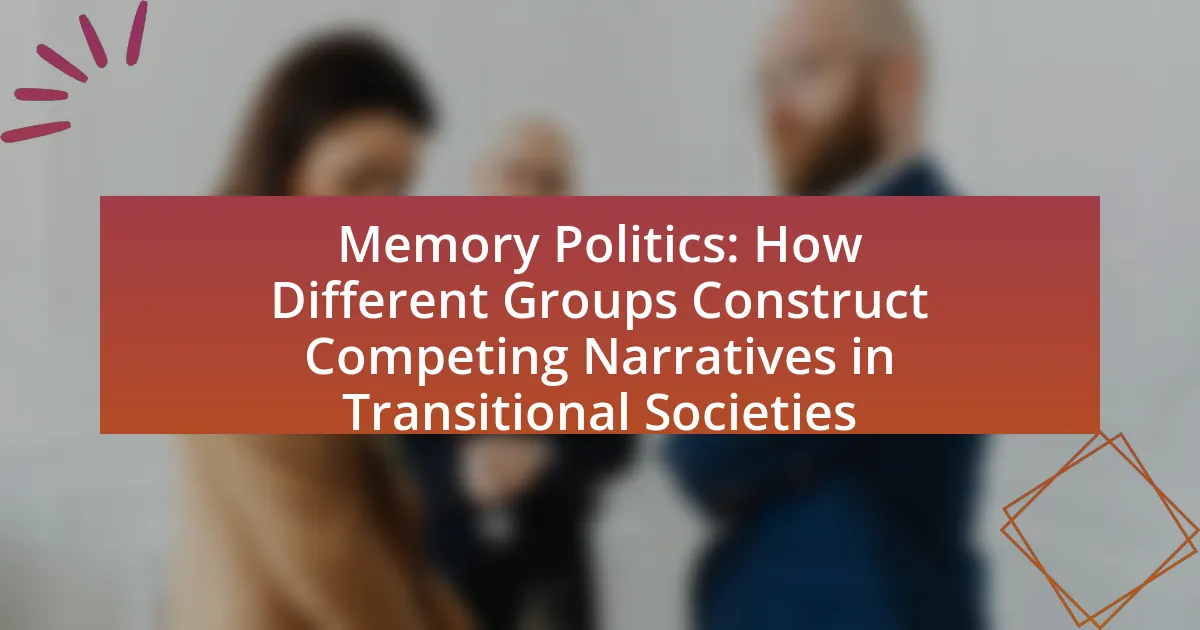Memorials serve a vital function in preserving historical memory during transitional justice processes by acting as sites of remembrance and reflection for communities impacted by past atrocities. They facilitate public acknowledgment of suffering, promote collective healing, and educate future generations about historical injustices. The article explores the various types of memorials established in transitional contexts, their role in fostering dialogue and reconciliation, and the psychological impacts on survivors and communities. It also addresses the challenges memorials face, including political resistance and differing societal narratives, while highlighting best practices for their design and implementation to enhance their effectiveness in promoting historical awareness and societal change.
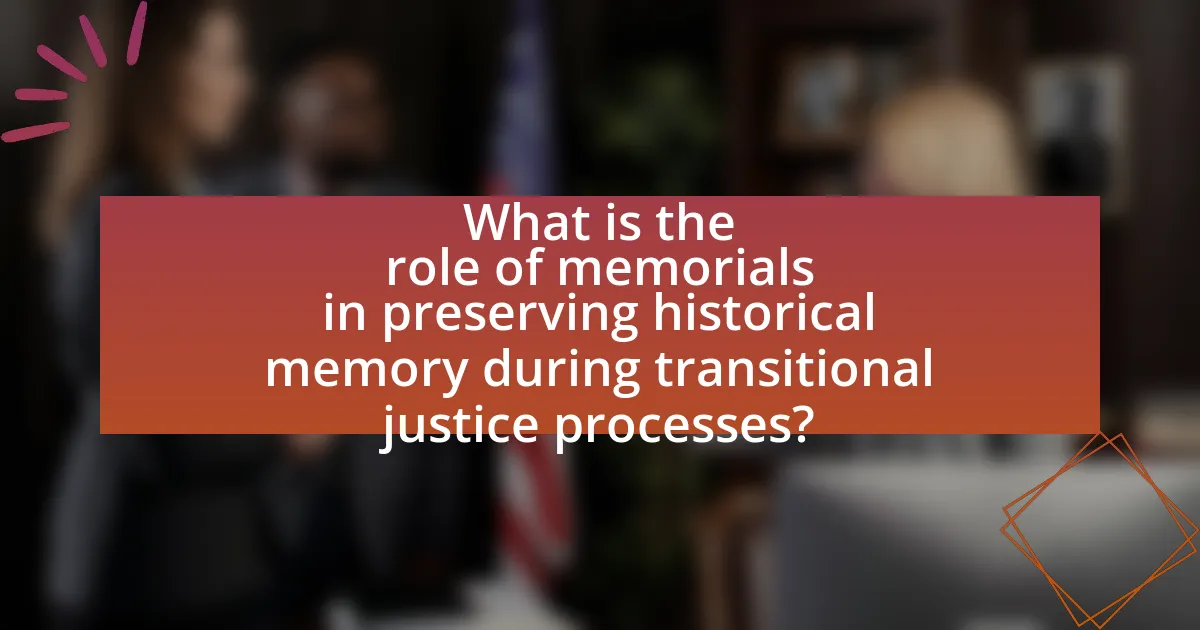
What is the role of memorials in preserving historical memory during transitional justice processes?
Memorials play a crucial role in preserving historical memory during transitional justice processes by serving as sites of remembrance and reflection for communities affected by past atrocities. They facilitate public acknowledgment of suffering and promote collective healing by commemorating victims and educating future generations about historical injustices. For instance, the Truth and Reconciliation Commission in South Africa emphasized the importance of memorials in fostering national unity and reconciliation after apartheid, highlighting how these structures can help societies confront their past and build a more just future.
How do memorials contribute to collective memory in societies undergoing transition?
Memorials contribute to collective memory in societies undergoing transition by serving as physical representations of historical events and shared experiences. They facilitate public reflection and dialogue about past injustices, helping communities to process trauma and acknowledge suffering. For instance, the Truth and Reconciliation Commission in South Africa emphasized the importance of memorials in fostering national healing after apartheid, illustrating how these structures can promote understanding and reconciliation. By commemorating victims and significant events, memorials reinforce a collective identity and ensure that the lessons of the past are not forgotten, thereby shaping future societal values and norms.
What types of memorials are commonly established in transitional justice contexts?
In transitional justice contexts, commonly established memorials include commemorative monuments, museums, and memorial parks. Commemorative monuments often honor victims of violence or oppression, serving as public reminders of past injustices. Museums dedicated to transitional justice frequently exhibit artifacts, documents, and narratives that educate the public about historical events and their impacts. Memorial parks provide spaces for reflection and remembrance, often incorporating elements like plaques or sculptures that commemorate specific events or individuals. These types of memorials play a crucial role in preserving historical memory and fostering societal healing by acknowledging past atrocities and promoting awareness.
How do these memorials reflect the historical narratives of affected communities?
Memorials reflect the historical narratives of affected communities by serving as tangible representations of their collective experiences and traumas. These structures often commemorate specific events, such as conflicts or injustices, thereby validating the suffering and resilience of those communities. For instance, the Vietnam Veterans Memorial in Washington, D.C., honors the sacrifices of soldiers and acknowledges the pain of their families, reinforcing the narrative of loss and remembrance within American society. Additionally, memorials like the Apartheid Museum in South Africa encapsulate the struggle against racial oppression, providing a space for reflection and education about the community’s history. Such memorials not only preserve memory but also foster dialogue and healing, ensuring that the narratives of affected communities are recognized and remembered in the broader historical context.
Why are memorials important for reconciliation in post-conflict societies?
Memorials are important for reconciliation in post-conflict societies because they serve as tangible reminders of the past, fostering collective memory and promoting healing. By commemorating victims and acknowledging the suffering endured during conflicts, memorials facilitate dialogue among communities, helping to bridge divides and build trust. Research indicates that societies with established memorials experience lower levels of violence and increased social cohesion, as these sites encourage reflection and understanding of shared histories. For instance, the Truth and Reconciliation Commission in South Africa emphasized the role of memorials in acknowledging injustices, which contributed to the nation’s healing process after apartheid.
How do memorials facilitate dialogue among different societal groups?
Memorials facilitate dialogue among different societal groups by serving as physical spaces for reflection and discussion about shared histories and experiences. These structures often commemorate significant events or individuals, prompting diverse groups to engage in conversations about their differing perspectives and interpretations of history. For instance, memorials dedicated to victims of conflict can encourage dialogue between survivors and perpetrators, fostering understanding and reconciliation. Research indicates that memorials can act as catalysts for community engagement, as seen in the case of the Apartheid Museum in South Africa, which invites visitors from various backgrounds to confront the complexities of the nation’s past and promotes discussions on race, justice, and healing.
What psychological impacts do memorials have on survivors and communities?
Memorials have significant psychological impacts on survivors and communities by facilitating grief processing and fostering collective memory. They serve as spaces for reflection, allowing individuals to confront trauma and honor lost lives, which can lead to healing and resilience. Research indicates that memorials can enhance community cohesion by providing a shared space for remembrance, thereby reinforcing social bonds among survivors. For instance, a study published in the Journal of Peace Research highlights that communities with memorials report higher levels of social trust and collective identity, which are crucial for recovery in post-conflict settings.
What challenges do memorials face in transitional justice processes?
Memorials face significant challenges in transitional justice processes, primarily due to political resistance, differing societal narratives, and resource limitations. Political resistance often arises when governments or influential groups oppose the establishment of memorials that contradict their narratives or threaten their legitimacy. For instance, in post-apartheid South Africa, debates over memorialization reflect ongoing tensions regarding historical interpretation. Differing societal narratives complicate the creation of inclusive memorials, as communities may have conflicting views on events, leading to divisions rather than reconciliation. Additionally, resource limitations hinder the development and maintenance of memorials, as funding and support may be insufficient in transitional contexts where priorities are often focused on immediate socio-economic issues. These challenges collectively impact the effectiveness of memorials in fostering healing and preserving historical memory.
How do political contexts influence the establishment and maintenance of memorials?
Political contexts significantly influence the establishment and maintenance of memorials by shaping the narratives that are deemed important for collective memory. For instance, in post-conflict societies, governments may establish memorials to promote national unity or to commemorate specific events that align with their political agendas, such as the establishment of the National September 11 Memorial in the United States, which serves to honor victims while reinforcing national identity. Conversely, political regimes may neglect or dismantle memorials that do not fit their ideological framework, as seen in various authoritarian regimes that erase symbols of dissent or historical grievances. The maintenance of these memorials often reflects ongoing political power dynamics, where funding and public support can fluctuate based on the prevailing political climate, as evidenced by the varying levels of state support for memorials in countries undergoing transitional justice, such as South Africa’s Truth and Reconciliation Commission memorials.
What controversies arise around the narratives presented in memorials?
Controversies surrounding the narratives presented in memorials often stem from differing interpretations of historical events and the selective commemoration of certain figures or incidents. These disputes can arise when memorials reflect a particular political or ideological perspective, leading to accusations of bias or exclusion of marginalized voices. For instance, memorials dedicated to national heroes may overlook the suffering of oppressed groups, creating a narrative that favors one side of a conflict while silencing others. Additionally, the process of deciding which events or individuals to memorialize can provoke public debate, as seen in the controversies over monuments related to colonialism or civil rights, where communities may clash over the appropriateness of honoring certain legacies. Such controversies highlight the complex relationship between memory, identity, and power in the context of transitional justice processes.
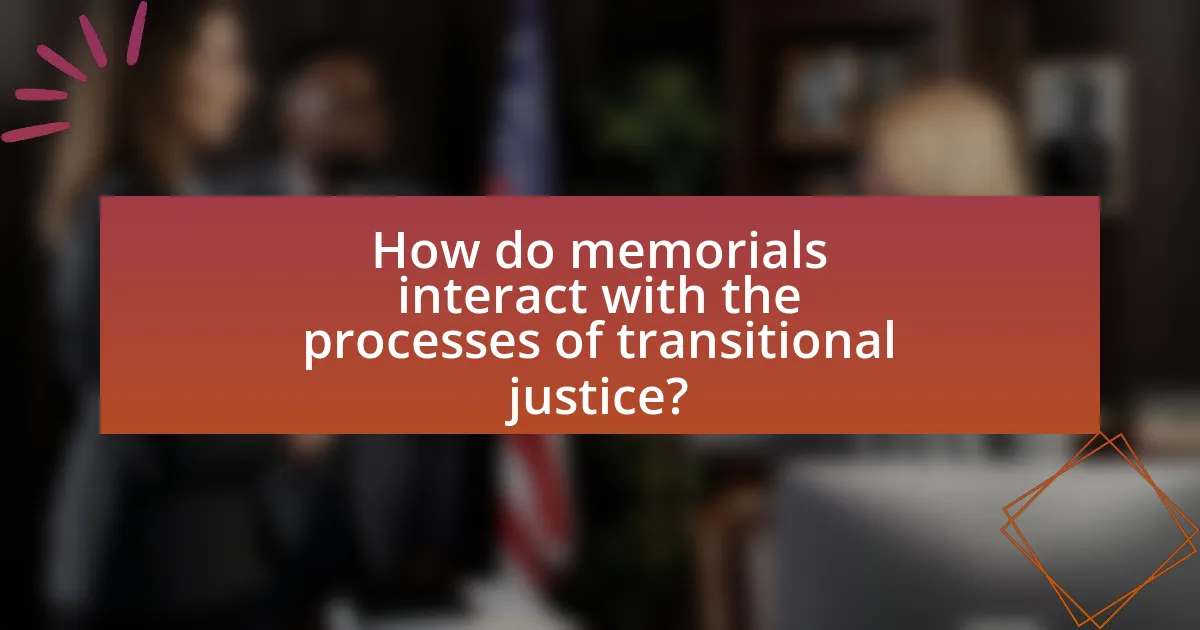
How do memorials interact with the processes of transitional justice?
Memorials interact with the processes of transitional justice by serving as sites for remembrance, reconciliation, and acknowledgment of past atrocities. They facilitate public engagement with historical narratives, allowing communities to confront collective trauma and promote healing. For instance, memorials dedicated to victims of political violence, such as the Memorial to the Victims of the Military Dictatorship in Argentina, play a crucial role in fostering dialogue about human rights abuses and ensuring that such events are not forgotten. This interaction supports transitional justice goals by promoting accountability, educating future generations, and contributing to a shared understanding of history, which is essential for building a just society.
What role do memorials play in the truth-telling aspect of transitional justice?
Memorials serve a crucial role in the truth-telling aspect of transitional justice by providing a physical space for remembrance and acknowledgment of past atrocities. They facilitate public engagement with historical narratives, allowing communities to confront and reflect on the injustices experienced. For instance, memorials like the Vietnam Veterans Memorial in the United States not only honor the victims but also encourage dialogue about the war’s impact, contributing to a collective understanding of history. This process of remembrance is essential for healing and reconciliation, as it validates the experiences of victims and fosters a shared commitment to preventing future violations.
How do memorials support the documentation of human rights violations?
Memorials support the documentation of human rights violations by serving as physical representations of the events and experiences of victims, thereby preserving their stories and ensuring public acknowledgment. These structures often include detailed accounts, names, and narratives that highlight specific atrocities, which contribute to historical records and collective memory. For instance, the Memorial to the Murdered Jews of Europe in Berlin documents the Holocaust, providing a space for reflection and education about the systematic extermination of millions. This documentation is crucial for fostering awareness, promoting accountability, and preventing future violations, as it encourages societies to confront their past and recognize the importance of human rights.
What is the relationship between memorials and legal accountability in transitional justice?
Memorials play a crucial role in fostering legal accountability in transitional justice by serving as sites of remembrance and platforms for public discourse about past atrocities. They contribute to the collective memory of victims and survivors, which can pressure legal systems to pursue justice and hold perpetrators accountable. For instance, memorials often highlight the narratives of those affected by human rights violations, thereby influencing public opinion and encouraging legal reforms. Research indicates that societies with established memorials are more likely to engage in legal proceedings against past offenders, as seen in countries like Argentina, where the memory of the Dirty War has led to numerous trials and convictions of military officials. This relationship underscores the importance of memorials in not only preserving historical memory but also in promoting accountability within transitional justice frameworks.
How do memorials influence public policy and societal change?
Memorials influence public policy and societal change by serving as focal points for collective memory and advocacy. They often catalyze discussions about historical injustices, prompting legislative reforms and shifts in societal attitudes. For instance, the Vietnam Veterans Memorial in Washington, D.C., has played a significant role in shaping public discourse around veterans’ rights and mental health policies, leading to increased support for veteran services. Additionally, memorials dedicated to victims of violence, such as the Holocaust Memorial in Berlin, have contributed to policies aimed at combating hate crimes and promoting tolerance. These examples illustrate how memorials not only commemorate the past but also actively shape contemporary policy and societal values.
What examples exist of memorials leading to legislative reforms?
Memorials have led to legislative reforms in various instances, notably the Vietnam Veterans Memorial influencing the establishment of the Veterans’ Compensation Cost-of-Living Adjustment Act in 1989. This act was a direct response to the public’s heightened awareness of veterans’ issues following the memorial’s dedication in 1982, which highlighted the sacrifices of Vietnam War veterans. Another example is the 9/11 Memorial in New York City, which played a significant role in the passage of the James Zadroga 9/11 Health and Compensation Act in 2010, providing health benefits to first responders affected by the attacks. These memorials not only honor the memory of those lost but also catalyze legislative action addressing the needs of affected communities.
How can memorials serve as educational tools for future generations?
Memorials serve as educational tools for future generations by providing tangible reminders of historical events and fostering critical reflection on societal issues. They often include inscriptions, artifacts, and guided tours that convey the significance of the events they commemorate, such as wars, genocides, or civil rights movements. For instance, the Vietnam Veterans Memorial in Washington, D.C., not only honors those who served but also educates visitors about the complexities of the Vietnam War and its impact on American society. Research indicates that memorials can enhance understanding of historical narratives and promote discussions about justice, reconciliation, and the consequences of conflict, thereby shaping the collective memory and identity of communities.
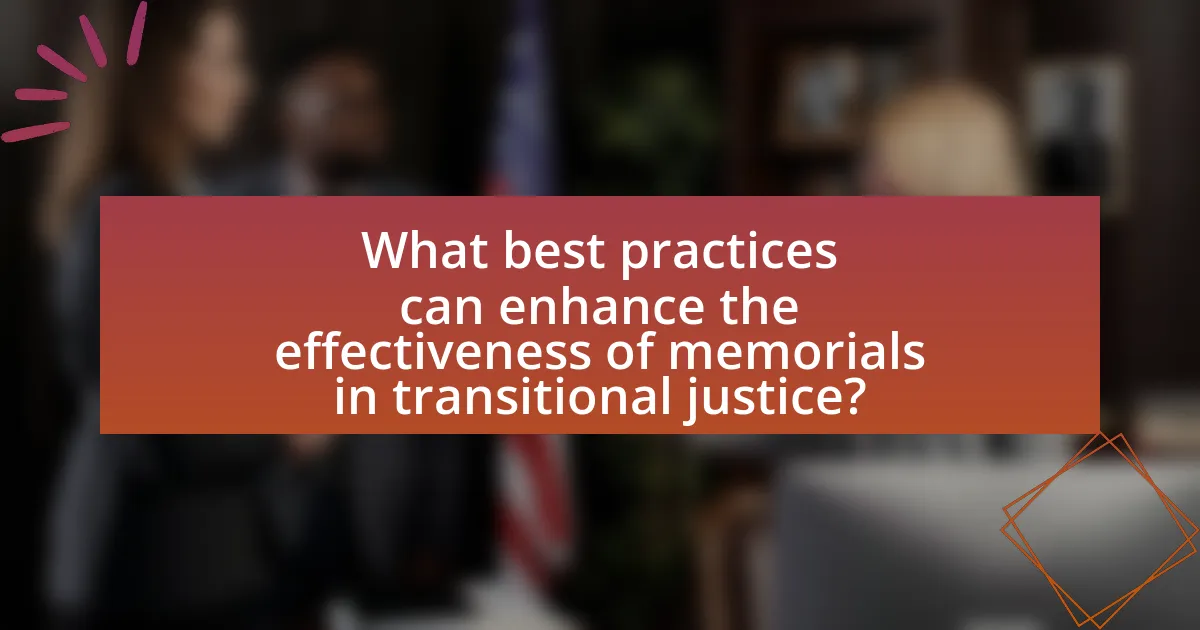
What best practices can enhance the effectiveness of memorials in transitional justice?
Best practices that can enhance the effectiveness of memorials in transitional justice include community involvement, educational integration, and emotional accessibility. Community involvement ensures that memorials reflect the collective memory and experiences of those affected, fostering a sense of ownership and relevance. Educational integration allows memorials to serve as tools for teaching future generations about past injustices, promoting awareness and understanding. Emotional accessibility, achieved through thoughtful design and inclusive narratives, helps individuals connect with the memorial on a personal level, facilitating healing and reflection. These practices are supported by case studies, such as the Apartheid Museum in South Africa, which emphasizes community engagement and education, demonstrating their effectiveness in promoting reconciliation and historical awareness.
How can community involvement improve the design and purpose of memorials?
Community involvement can significantly enhance the design and purpose of memorials by ensuring that they reflect the values, experiences, and needs of the local population. Engaging community members in the design process fosters a sense of ownership and connection to the memorial, making it more meaningful and relevant. For instance, studies have shown that memorials designed with community input are more likely to resonate emotionally with visitors, as they incorporate local narratives and cultural symbols. This participatory approach not only honors the collective memory of the community but also promotes healing and reconciliation, particularly in contexts of transitional justice, where memorials serve as sites for reflection and dialogue about past injustices.
What strategies can be employed to ensure diverse voices are represented in memorials?
To ensure diverse voices are represented in memorials, inclusive community engagement strategies must be employed. These strategies involve actively involving various stakeholders, including marginalized groups, in the planning and design processes of memorials. Research indicates that memorials that incorporate input from diverse communities reflect a broader spectrum of historical narratives and experiences, thereby fostering a more comprehensive understanding of the past. For instance, the National Memorial for Peace and Justice in Montgomery, Alabama, was developed through extensive consultations with local communities, ensuring that the voices of African Americans affected by racial violence were central to its narrative. This approach not only honors diverse histories but also promotes healing and reconciliation in transitional justice contexts.
How can memorials be integrated into broader educational initiatives?
Memorials can be integrated into broader educational initiatives by serving as focal points for teaching historical events and promoting critical discussions about justice, memory, and reconciliation. For instance, educational programs can include field trips to memorial sites, where students engage in guided discussions that connect the memorial’s significance to broader themes of human rights and social justice. Research indicates that experiential learning, such as visiting memorials, enhances students’ understanding of complex historical narratives and fosters empathy (Falk & Dierking, 2016). Additionally, curriculum development can incorporate memorials as case studies, allowing students to analyze the impact of historical events on contemporary society, thereby reinforcing the educational value of these sites in transitional justice contexts.
What lessons can be learned from successful memorial projects worldwide?
Successful memorial projects worldwide demonstrate the importance of community involvement, historical accuracy, and emotional resonance. Community engagement ensures that the memorial reflects the collective memory and values of those it represents, as seen in the Vietnam Veterans Memorial in Washington, D.C., which was designed with input from veterans and their families. Historical accuracy is crucial, as exemplified by the Holocaust Memorial in Berlin, which confronts the atrocities of the past directly, fostering education and remembrance. Emotional resonance is achieved through design elements that evoke feelings, such as the 9/11 Memorial in New York City, which uses water features and open space to create a contemplative environment. These projects highlight that successful memorials must be inclusive, truthful, and impactful to effectively preserve historical memory during transitional justice processes.
What are the key factors that contribute to the sustainability of memorials?
The key factors that contribute to the sustainability of memorials include community engagement, ongoing funding, and adaptive management practices. Community engagement ensures that memorials remain relevant and supported by local populations, as seen in the case of the Vietnam Veterans Memorial, where veterans and families actively participate in maintenance and programming. Ongoing funding is crucial for the upkeep and preservation of memorials; for instance, the National Park Service allocates resources for the maintenance of national memorials in the United States. Adaptive management practices allow memorials to evolve with changing societal values and historical interpretations, as demonstrated by the reinterpretation of the Holocaust Memorial in Berlin to include diverse narratives. These factors collectively enhance the longevity and impact of memorials in preserving historical memory.
How can technology be leveraged to enhance the impact of memorials?
Technology can enhance the impact of memorials by integrating interactive digital elements that engage visitors and provide deeper historical context. For instance, augmented reality (AR) applications can allow users to visualize historical events at the memorial site, creating a more immersive experience. Additionally, digital storytelling platforms can share personal narratives and testimonies, fostering emotional connections and understanding of the events commemorated. Research indicates that interactive memorials can increase visitor engagement by up to 50%, as seen in projects like the 9/11 Memorial Museum, which utilizes multimedia exhibits to convey the significance of the events. These technological enhancements not only preserve historical memory but also facilitate a more profound dialogue about transitional justice.
What practical steps can communities take to create effective memorials?
Communities can create effective memorials by engaging in inclusive planning processes that involve diverse stakeholders. This ensures that the memorial reflects the collective memory and experiences of all affected groups. For instance, communities can conduct public consultations to gather input on design, location, and significance, which fosters a sense of ownership and relevance. Additionally, incorporating educational elements, such as plaques or interactive displays, can enhance understanding of the historical context and promote ongoing dialogue. Research indicates that memorials that actively involve the community in their creation are more likely to resonate and serve their intended purpose, as seen in the success of the National Memorial for Peace and Justice in Montgomery, Alabama, which emphasizes collective remembrance and education.
